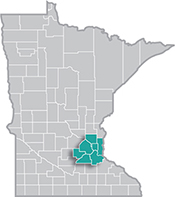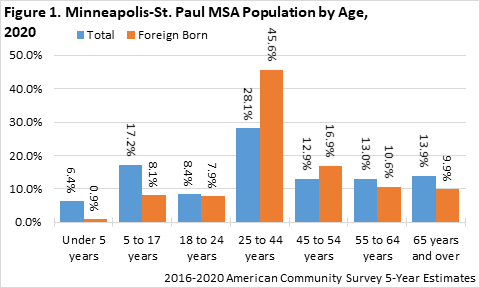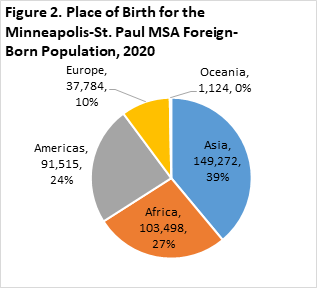 The Minneapolis-St. Paul metropolitan area is a national leader in finance, advanced manufacturing, agriculture and retailing.
The Minneapolis-St. Paul metropolitan area is a national leader in finance, advanced manufacturing, agriculture and retailing.
Medical devices, electronics and processed foods are strong suits recognized globally.
Want the freshest data delivered by email? Subscribe to our regional newsletters.
5/17/2022 9:00:00 AM
Tim O'Neill
Let's celebrate the significant and growing contributions of immigrants, temporary migrants, refugees and asylees, and other foreign-born migrants to the Metro Area's labor force and economy as a whole. This blog post takes a look at the foreign-born population in the wider Minneapolis-St. Paul Metropolitan Statistical Area (MSA) with the most recent data from the U.S. Census Bureau's 2016-2020 American Community Survey (ACS) 5-year estimates.
According to the U.S. Census Bureau, the foreign-born population "refers to anyone who is not a U.S. citizen at birth…this includes naturalized U.S. citizens, lawful permanent residents (immigrants), temporary migrants (such as foreign students), humanitarian migrants (such as refugees and asylees), and unauthorized migrants."
The 2020 ACS 5-year estimates put the Minneapolis-St. Paul MSA's foreign-born population at nearly 383,200 people. As such, over one-in-ten residents of the MSA (10.6%) were foreign-born persons. And this population has grown rapidly in recent years. Between the 2015 and 2020 5-year estimates, the MSA's foreign-born population expanded by 11.6%, equivalent to about 39,700 additional people. Comparatively, the region's total population expanded by 4.2%, which was equivalent to about 146,700 people. In other words, the foreign-born population accounted for 27.1% of the MSA's total population expansion between the 2015 and 2020 5-year estimates.
The foreign-born population has become especially significant within the MSA's labor force. More specifically, the foreign-born population accounted for 12.8% of the MSA's population 16 years of age and older participating in the labor force in 2020. This is equivalent to over 260,700 people. Between the 2015 and 2020 5-year ACS estimates, the foreign-born population participating in the labor force expanded by 14.2%, or nearly 32,400 people. That means this population accounted for 41.2% of the region's total labor force growth during that period.
 The more rapid growth of the MSA's foreign-born population participating in the labor force is partly due to this population's age distribution. When compared with the total population, a much higher share of foreign-born persons in the MSA are between the ages of 25 and 54 years. This age cohort is often labeled the "prime working age" population, as persons between 25 and 54 years have the highest labor force participation rates. As of 2020, 62.5% of the MSA's foreign-born population was between 25 and 54 years of age. This compares to just 41.0% for the total population (Figure 1).
The more rapid growth of the MSA's foreign-born population participating in the labor force is partly due to this population's age distribution. When compared with the total population, a much higher share of foreign-born persons in the MSA are between the ages of 25 and 54 years. This age cohort is often labeled the "prime working age" population, as persons between 25 and 54 years have the highest labor force participation rates. As of 2020, 62.5% of the MSA's foreign-born population was between 25 and 54 years of age. This compares to just 41.0% for the total population (Figure 1).
Of the Minneapolis-St. Paul MSA's 383,193 foreign-born residents, nearly two-in-five (149,272 people) were born in Asia. Those Asian counties contributing the most to this population include India (28,546 people), Laos (22,397 people), China (17,590 people), Thailand (16,875 people), and Vietnam (14,820 people).
Over one-in-four of the MSA's foreign-born residents were born in Africa (103,498 people). Those African countries contributing the most to this population include Somalia (28,389 people), Ethiopia (20,935 people), Kenya (11,866 people), and Liberia (11,211 people).
 Nearly one-in-four additional foreign-born residents of the Minneapolis-St. Paul MSA hail from the Americas. Nearly half of these residents have moved to the region from Mexico (42,790 people). Large numbers of residents have also moved to the region from Canada (8,057 people), El Salvador (6,198 people), and Ecuador (5,851 people).
Nearly one-in-four additional foreign-born residents of the Minneapolis-St. Paul MSA hail from the Americas. Nearly half of these residents have moved to the region from Mexico (42,790 people). Large numbers of residents have also moved to the region from Canada (8,057 people), El Salvador (6,198 people), and Ecuador (5,851 people).
About one-in-ten foreign-born residents in the Minneapolis-St. Paul MSA were born in Europe. Those countries in Europe contributing the most to the MSA's foreign-born population include Russia (5,691 people), Germany (4,979 people), the United Kingdom (4,596 people), and Ukraine (3,968 people).
While a smaller population, 1,124 foreign-born residents in the Minneapolis-St. Paul MSA were born in Oceania. Most of these persons (948 people) were born in Australia or New Zealand.
| Table 1. Place of Birth for the Minneapolis-St. Paul MSA Foreign-Born Population | ||||
|---|---|---|---|---|
| Area | 2020 Estimate | 2010 Estimate | 2010 – 2020 Population Change | |
| Numeric | Percent | |||
| Total Population | 3,605,450 | 3,229,181 | +376,269 | +11.7% |
| Total Foreign-Born Population | 383,193 | 301,441 | +81,752 | +27.1% |
| Asia | 149,272 | 116,837 | +32,435 | +27.8% |
| South Eastern Asia | 72,619 | 62,564 | +10,055 | +16.1% |
| South Central Asia | 39,475 | 24,939 | +14,536 | +58.3% |
| Eastern Asia | 30,670 | 24,805 | +5,865 | +23.6% |
| Western Asia | 6,225 | 4,274 | +1,951 | +45.6% |
| Africa | 103,498 | 61,891 | +41,607 | +67.2% |
| Eastern Africa | 67,885 | 38,344 | +29,541 | +77.0% |
| Western Africa | 24,471 | 15,973 | +8,498 | +53.2% |
| Northern Africa | 5,215 | 3,584 | +1,631 | +45.5% |
| Middle Africa | 3,105 | 1,242 | +1,863 | +150.0% |
| Southern Africa | 1,282 | 717 | +565 | +78.8% |
| Americas | 91,515 | 85,988 | +5,527 | +6.4% |
| Latin America | 83,398 | 77,559 | +5,839 | +7.5% |
| Northern America | 8,117 | 8,429 | -312 | -3.7% |
| Europe | 37,784 | 35,881 | +1,903 | +5.3% |
| Eastern Europe | 20,903 | 20,095 | +808 | +4.0% |
| Western Europe | 7,870 | 7,617 | +253 | +3.3% |
| Northern Europe | 6,720 | 6,524 | +196 | +3.0% |
| Southern Europe | 2,224 | 1,620 | +604 | +37.3% |
| Oceania | 1,124 | 844 | +280 | +33.2% |
| Australia and New Zealand | 948 | 669 | +279 | +41.7% |
| Source: U.S. Census Bureau, American Community Survey 2010 and 2020 5-Year Estimates | ||||
Zooming out, the Minneapolis-St. Paul MSA's foreign-born population expanded by 27.1% between the 2010 and 2020 ACS 5-year estimates. This was over twice the growth rate for the total population in the region (+11.7%). The region's foreign-born population from Africa witnessed both the largest and fastest growth between the 2010 and 2020 ACS estimates (+67.2%; +41,607 people). The region's foreign-born population from Asia also experienced significant growth during this period (+27.8%; +32,435 people) (Table 1).
Contact Tim O'Neill, Labor Market Analyst.